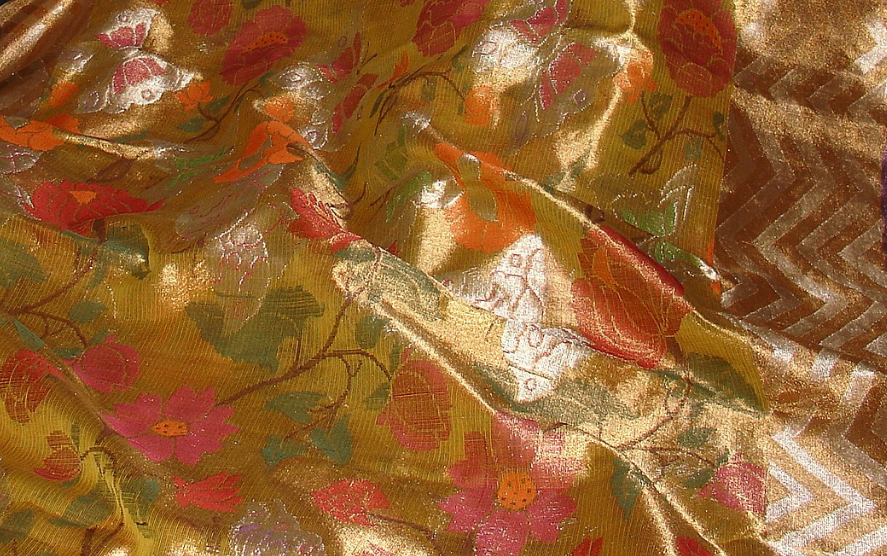Delve into the rich tapestry of Indian textiles with the Kota Doria Silk Saree, a masterpiece that seamlessly blends tradition with contemporary elegance. Originating from the heritage-rich town of Kota in Rajasthan, these sarees are celebrated for their fine texture, intricate weaving, and lightweight feel. In this exploration, we unravel the story of Kota Doria Silk Sarees, from their inception to the reasons behind their enduring popularity.
What is a Kota Doria Silk Saree?
The Kota Doria Silk Saree is a traditional handwoven textile that hails from the historic city of Kota. Characterized by a unique square-check pattern (known as khats), lightweight texture, and silk yarn, these sarees exude a graceful charm that has stood the test of time.
When Did the Legacy Begin?
The roots of Kota Doria weaving can be traced back to the late 17th century during the reign of Maharao Kishore Singh. However, it was in the 18th century under the patronage of Maharaja Bhim Singh that the craft flourished. Kota Doria Silk Sarees gained royal favor, and their legacy continued through generations.
Where Are Kota Doria Silk Sarees Woven?
Authentic Kota Doria Silk Sarees are handwoven in the city of Kota and nearby villages in Rajasthan. The traditional craft has been passed down through generations, with weavers meticulously creating these sarees using age-old techniques.
Who Adorns Kota Doria Silk Sarees?
Kota Doria Silk Sarees are favored by women who appreciate the combination of tradition and modern aesthetics. These sarees are suitable for various occasions, from casual gatherings to formal events. The lightweight nature of the fabric makes them an ideal choice for the scorching Indian summers.
Why Choose Kota Doria Silk Saree?
- Fine Weaving: The hallmark of Kota Doria Silk Sarees is their fine square-check pattern, created through a unique weaving technique. The intricate weave adds to the allure of the saree.
- Lightweight Texture: Kota Doria Silk Sarees are known for their feather-light feel, making them comfortable to wear even in hot weather. The breathable fabric ensures ease of movement.
- Silk Yarn: The use of silk yarn enhances the richness of Kota Doria sarees. The silk threads contribute to the luxurious texture and impart a subtle sheen to the fabric.
- Versatility: Kota Doria Silk Sarees come in a range of colors and designs, making them versatile for various occasions. From vibrant hues for festivals to subtle tones for everyday wear, there's a Kota Doria saree for every mood.
- Craftsmanship: The weaving of Kota Doria Silk Sarees is a labor-intensive process that requires skill and precision. Supporting these handwoven sarees promotes traditional craftsmanship.
Consumption of Kota Doria Silk Saree in India:
Kota Doria Silk Sarees have found a place in the hearts and wardrobes of Indian women. Their popularity extends beyond Rajasthan, with women across the country appreciating the elegance and comfort that these sarees offer.
Benefits of Kota Doria Silk Saree:
- Comfort in Summers: The lightweight and breathable nature of Kota Doria Silk Sarees makes them a preferred choice, especially during the scorching Indian summers.
- Elegance with Simplicity: Kota Doria sarees strike a perfect balance between elegance and simplicity. The subtle check pattern adds sophistication to the saree without being overpowering.
- Craftsmanship Appreciation: Wearing a Kota Doria Silk Saree is not just about donning a piece of clothing; it's a celebration of the craftsmanship that goes into creating each saree.
Disadvantage or Why Try Other Sarees?
While Kota Doria Silk Sarees are beloved for their qualities, individuals may explore other saree varieties based on specific preferences:
- Heavier Occasions: For grand occasions that demand heavily embellished sarees, individuals may opt for silk sarees with more intricate zari or embroidery work.
- Seasonal Variety: While Kota Doria Silk Sarees are ideal for summers, individuals may seek heavier fabrics like Banarasi silk or Kanjeevaram silk for winter festivities.
Conclusion:
In conclusion, Kota Doria Silk Sarees stand as a testament to the enduring charm of traditional Indian textiles. Woven with precision and adorned with simplicity, these sarees capture the essence of Rajasthan's cultural heritage. As women drape themselves in the lightweight luxury of Kota Doria Silk, they not only embrace a timeless tradition but also contribute to the sustenance of a craft that reflects the soul of India's weaving legacy.
Distinct Types of Silk Sarees
India is renowned for its rich cultural heritage and diverse silk weaving traditions. Various regions across the country produce distinct types of silk sarees, each characterized by unique weaving techniques, designs, and cultural significance. Here are some popular types of silk sarees in India:
-
- Origin: Varanasi, Uttar Pradesh
- Features: Known for intricate zari work, gold and silver brocade, and vibrant colors. Often adorned with floral or Mughal-inspired motifs.
-
- Origin: Kanchipuram, Tamil Nadu
- Features: Characterized by rich silk, contrasting borders, and elaborate zari work. Traditional motifs include peacock and temple designs.
-
- Origin: Patan, Gujarat
- Features: Double ikat technique with vibrant geometric patterns. Patola sarees are known for their intricate designs and are usually a part of bridal trousseaus.
-
- Origin: Baluchar, West Bengal
- Features: Depicts mythological scenes and narratives through intricate brocade work. Borders and pallus often showcase detailed artistic designs.
-
- Origin: Chanderi, Madhya Pradesh
- Features: Light and translucent texture with fine zari work. Often adorned with traditional coin, floral, or peacock motifs.
-
- Origin: Mysore, Karnataka
- Features: Made from pure silk, these sarees are known for their simplicity and elegance. Often feature minimal zari work and vibrant colors.
-
- Origin: Bhagalpur, Bihar
- Features: Made from Tussar silk, these sarees have a rich texture and natural gold hue. Often adorned with ethnic prints and traditional motifs.
-
- Origin: Paithan, Maharashtra
- Features: Known for its peacock and flower motifs, these sarees have a silk base with vibrant zari borders. Paithani sarees are often worn during weddings and festivals.
-
- Origin: Kota, Rajasthan
- Features: Light and airy, with a unique square-check pattern. Often combined with silk to create elegant sarees.
-
- Origin: Rajasthan and Gujarat
- Features: Tie and dye technique creates intricate patterns on silk. Bandhani silk sarees are vibrant and popular during festivals and weddings.
These are just a few examples, and there are many more regional variations and types of silk sarees in India, each reflecting the cultural diversity and craftsmanship of the region it comes from.

